Troubleshooting Combustible Gas Detector
When using the fixed combustible gas detector, it is inevitable that there will be some failures. Then, why do these failures occur, and how can we troubleshoot them? The following are simple examples of several troubleshooting methods.
Improper installation of combustible gas detector
If the fixed combustible gas detector is not installed near the possible gas leakage points, or is adjacent to the exhaust fan when installed, the leaked gas will not diffuse to the combustible gas detector, so that the gas leak cannot be detected by the detector in time.
If the gas detector is not reliably grounded, and the electromagnetic interference cannot be eliminated, the working voltage will be affected, and the detection data will be inaccurate. Therefore, the flammable gas detector should be reliably grounded during the installation process.
If the combustible gas alarms and the wiring terminals is installed in places that are prone to collisions or water ingress, it will cause electrical circuit break or short circuit. For the detector welding, it must use non-corrosive flux; otherwise the joints will corrode and disconnect or increase the line resistance, which will affect the normal detection. Don't make the gas detector drop on the ground.
After the installation is completed, the debugging should be carried out to ensure that the gas detector can work properly.
Improper use of combustible gas detector
In the process of using the combustible gas detector, it should not be installed close to the air conditioner and heating equipment. If the cold or warm air directly flows to the gas detector, it may cause the change of electrical resistivity of the alarm platinum wire and then the error occurs. Therefore, the alarm should be located far away from air conditioners and heating equipment to avoid the gas detector failures caused by improper placement.
The electromagnetic interference should also be prevented when using the gas detector. It should consider all the aspects including the gas detector installation position, installation angel, protective measures and system wiring, etc. to prevent the EMI.
When using the fixed combustible gas detector, it need to consider the factors such as dust, high temperature, humidity, and rain, which also easily cause the detector failures.
When an exhaust fan needs to be installed in the field where the gas alarm is installed, if the exhaust fan is installed adjacent to the combustible gas detector, the leaked gas will not be able to diffuse to the gas alarm sufficiently and will not be detected in time, easily causing an accident. In this case, the installation site should be carefully considered.
When using the gas leak detector, avoid high temperature, high humidity, steam, and the places where oily smoke can reach.
Do not place or hang objects on the detector.
Once the gas detector is installed, it had better not change the position of the device arbitrarily.
Maintenance of combustible gas detector
The working environment of fixed combustible gas detectors is relatively harsh. Many of them are installed outdoors. Poor maintenance will result in measurement errors of the gas alarm or failure of the gas alarm. Therefore, regular cleaning and maintenance of combustible gas detector is an important work to prevent failure.
The grounding should be checked regularly. If the grounding does not meet the requirements of the standard or is not grounded at all, the fixed combustible gas detector will be susceptible to electromagnetic interference and cause malfunctions.
Before using the instruments, it is suggested to use the standard gas to conduct a response test to ensure that the instrument really plays a protective role. The combustible gas alarm and toxic gas alarm adopts a relatively comparative method to do the test just like other analysis and detection instruments: Use a zero gas and a standard concentration gas to calibrate the instrument to obtain a standard curve. During the measurement, compare the electrical signal generated by the gas concentration to be measured with the electrical signal of the standard concentration, calculate and obtain an accurate gas concentration value. Therefore, zero calibration of the instrument can be carried out at any time. Calibrating the instrument frequently can ensure the accuracy of the measurement.

